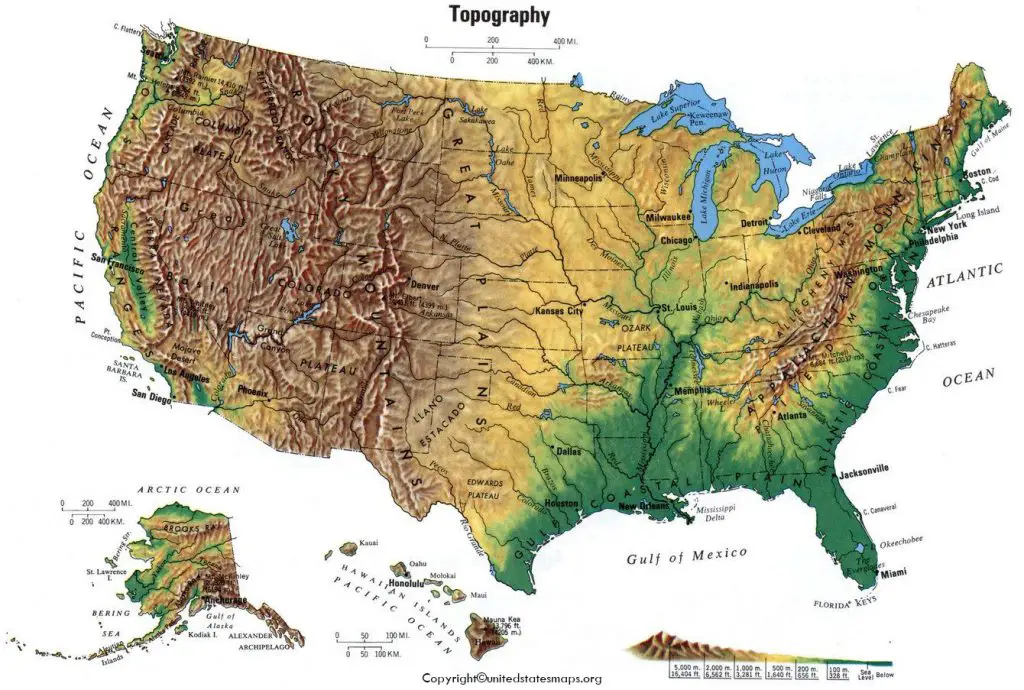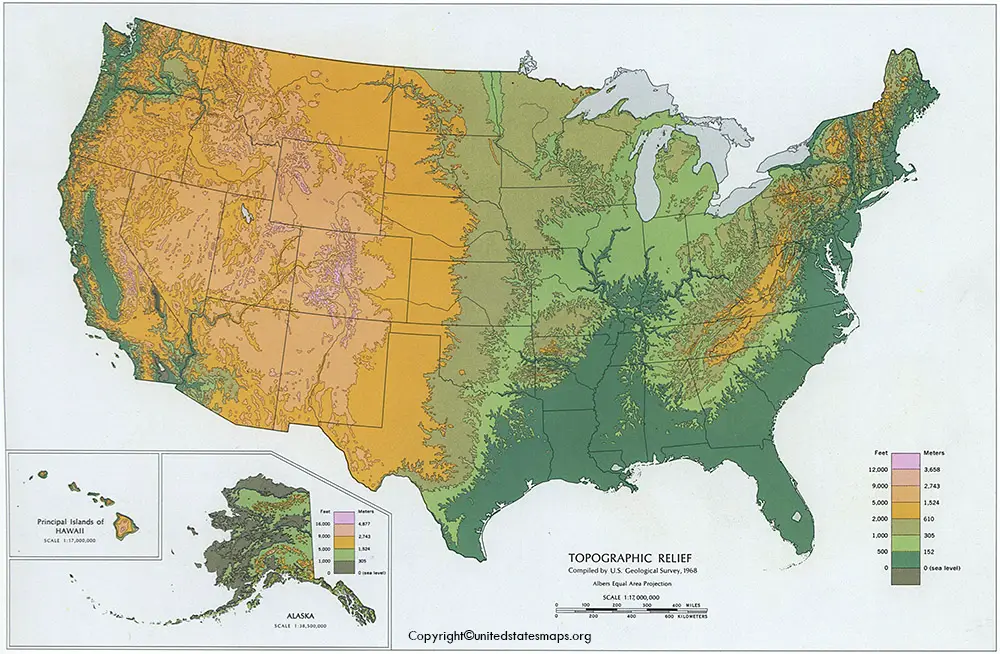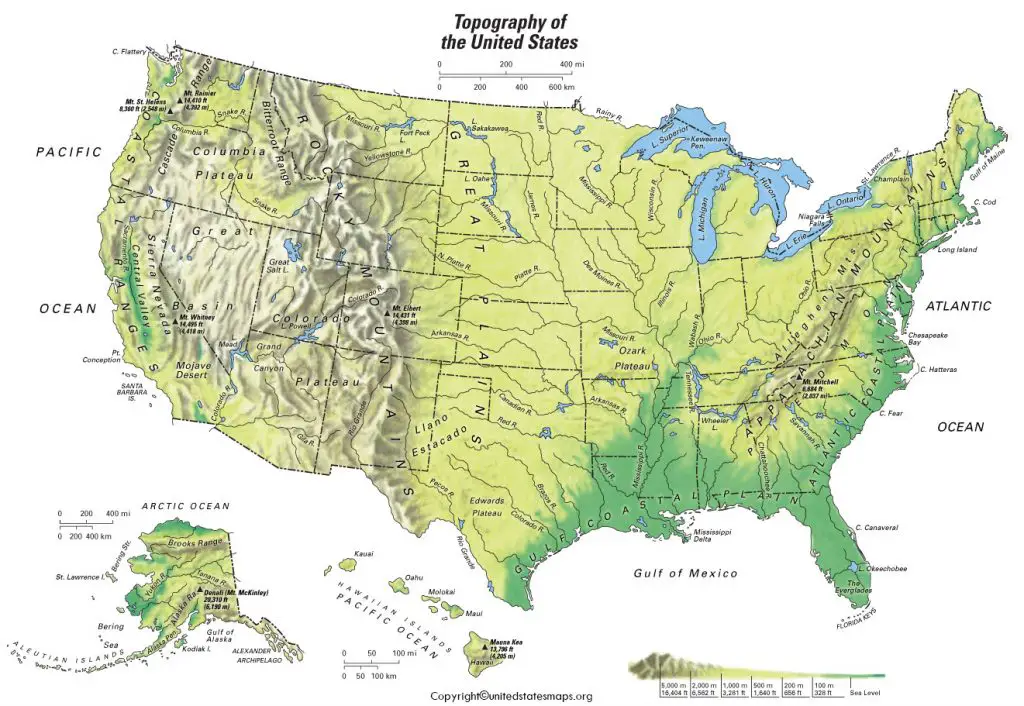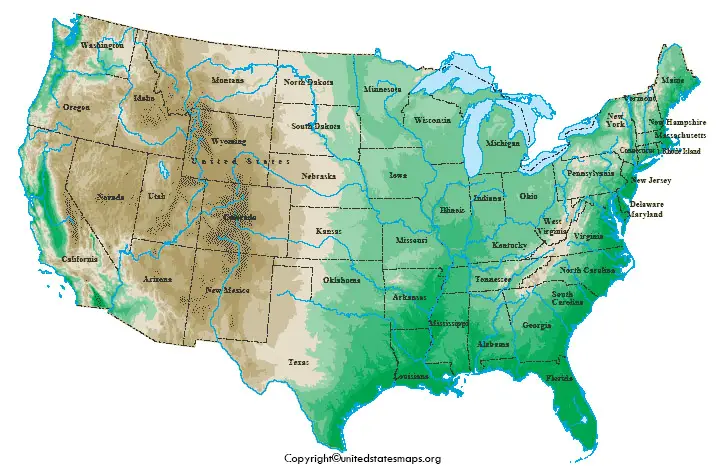US Topographic map shows the locations and forms of hills, valleys, streams, and others features as well as many man-made landmarks. They illustrate the shape and elevation of surfaces features by the use of contour lines. A type of map characterized by large-scale detail and quantitative representation of relief features using contour lines.
- US Voting Map
- US Climate Map
- US Pipeline Map
- Coronavirus US Map
- US Senate Map
- US Map with Capitals
- Interactive US map
- Map of southeast US
- Road Map of US
- Geographical Map of USA
- US surface Weather Map
- America Time Zone Map
US Topographic Map
Topographic map | Uses:
Can be used for various emergencies
- Emergency preparedness
- Urban planning
- Resource development
- Surveying to camping
- Surveying to canoeing
- Surveying to adventure racing
- Surveying to hunting, and fishing
How is a topographic map made?
U.S. Topographic maps were made using data from primary sources including direct field observations. Those US maps of Topographic were compiled, drawn, and edited clearly by hand. By today’s standard, these traditional methods are very expensive and time-consuming and the USGS has no longer fundings for this to make maps that way.
Topographic map – Characteristics & Purposes
The distinctive characteristic of a topographic map is the use of elevation contour lines to show the shape of the earth’s surface. Elevation contour lines are imaginary lines connecting points having the same elevation on the surface of the land above or below a reference surface, which usually means sea level.
US Topographic Map with States
Topographic map of USA – Types & Features
There are three types of topographic maps:
1: Karst topography- describes the distinct landscape that is made when underlying rocks dissolve or change shape.
2: Mountain topography- shows landforms such as hills and mountains.
3: Vegetation, elevation, and Glaciers
United States Topographic Map
This represents land cover imagery of the world and detailed topographic maps of the U.S. the Topographic map includes the NPS, the National earth’s physical map at 1.24 kilometers per pixel, maps for the contiguous united states at medium scales, and the national geographic topo. The TOPO! Maps are seamless scanned copies of images of United states geological survey paper topographic maps.
Topographic Map of USA
The contiguous United States, the state of Alaska, The island state of Hawaii, the five insular territories of Puerto Rico, Northern Mariana island, U.S. Virgin Islands, and minor outlying possessions. The USA shares its land borders with Canada country and Mexico and maritime borders with Russia, Cuba country, the Bahamas, and other countries. The northern border of the United States with Canada is the world’s longest binational land border.
Eastern US Topographic Map
Western US Topographic Map
Topographic map| Latitudes| Longitudes: are printed at the edges of the map alignment with the “0” on the latitude line recorded in step 3 and the edge intersecting the point. North line of the USA the small quadrangle.
Importance of topographic map : In agriculture, it determines the method of soil conservation and the flow of water. It helps in minimizing soil erosion by helping scientists in giving information on the landmass. Weather forecasting also gets benefits from it. Military uses this to gather information on the land area. They could plan their strategies with this map. Civil engineers and various government officers use it to perform their activities in an effective manner.
A U.S. Topographic Map is a detailed representation of the Earth’s surface, showcasing the natural and man-made features of a specific area. These maps are designed to provide accurate information for geographic, planning, and recreational purposes.
Key Features of a U.S. Topographic Map
1. Contour Lines
- Definition: Contour lines represent lines of equal elevation above sea level.
- Purpose: They show the shape and elevation of the terrain, allowing users to visualize hills, valleys, mountains, and plains.
- Spacing:
- Close contour lines indicate steep terrain.
- Wide contour lines signify gentle slopes or flat areas.
2. Relief Representation
- Relief is depicted using shaded relief, hachures, or contour lines to show changes in elevation and landform structures.
3. Scale
- Typically presented in scales like 1:24,000 (7.5-minute quadrangle maps) for detailed local areas or 1:250,000 for regional views.
- A smaller scale (e.g., 1:250,000) covers a larger area with less detail.
4. Symbols and Legends
- Natural Features:
- Rivers, lakes, and wetlands are marked with blue.
- Forested areas are often shaded green.
- Mountain peaks and cliffs are labeled with their elevation.
- Man-Made Features:
- Roads, highways, and railways.
- Buildings and urban areas.
- Dams, bridges, and other infrastructure.
- Land Boundaries:
- State and county borders.
- Property lines in some versions.
- Special Features:
- Hiking trails, campsites, and other recreational details.
5. Grid System
- Maps include a geographic coordinate system (latitude and longitude) and sometimes Universal Transverse Mercator (UTM) grid lines for precise location identification.
6. Elevation and Depth
- Elevation is marked in feet or meters.
- Depth of water bodies, such as lakes and coastal areas, may be included, especially in coastal maps.
7. Color Coding
- Brown: Contour lines and elevation.
- Green: Vegetation and forests.
- Blue: Water features.
- Black/Gray: Roads, railways, and urban features.
- Red: Highways and significant infrastructure.
8. Labels
- Names of physical features, such as mountains, valleys, rivers, and towns, are clearly labeled for easy identification.
Applications of U.S. Topographic Maps
- Navigation:
- Used by hikers, campers, and outdoor enthusiasts to traverse unfamiliar terrain.
- Urban Planning:
- Assists in city planning, infrastructure development, and zoning.
- Environmental Studies:
- Provides data for assessing ecosystems, soil erosion, and watershed management.
- Military Use:
- Critical for strategic planning, movement of troops, and identifying potential vantage points.
- Geological Studies:
- Useful for identifying rock formations, fault lines, and mineral deposits.
- Recreational Activities:
- Popular for hunting, fishing, and climbing.
- Emergency Management:
- Helps in disaster response planning, including flood mapping and wildfire management.
Modern U.S. Topographic Maps
In recent years, traditional paper maps have been supplemented with digital topographic maps. These maps:
- Are available through platforms like the USGS (United States Geological Survey) website.
- Allow for layering, customization, and integration with GPS.
- Offer real-time updates and 3D terrain visualization.
Significance
U.S. Topographic Maps are indispensable tools for understanding the geographical diversity of the United States. They serve as a foundation for numerous fields, from environmental conservation to adventure sports, offering a window into the terrain’s intricacies.



